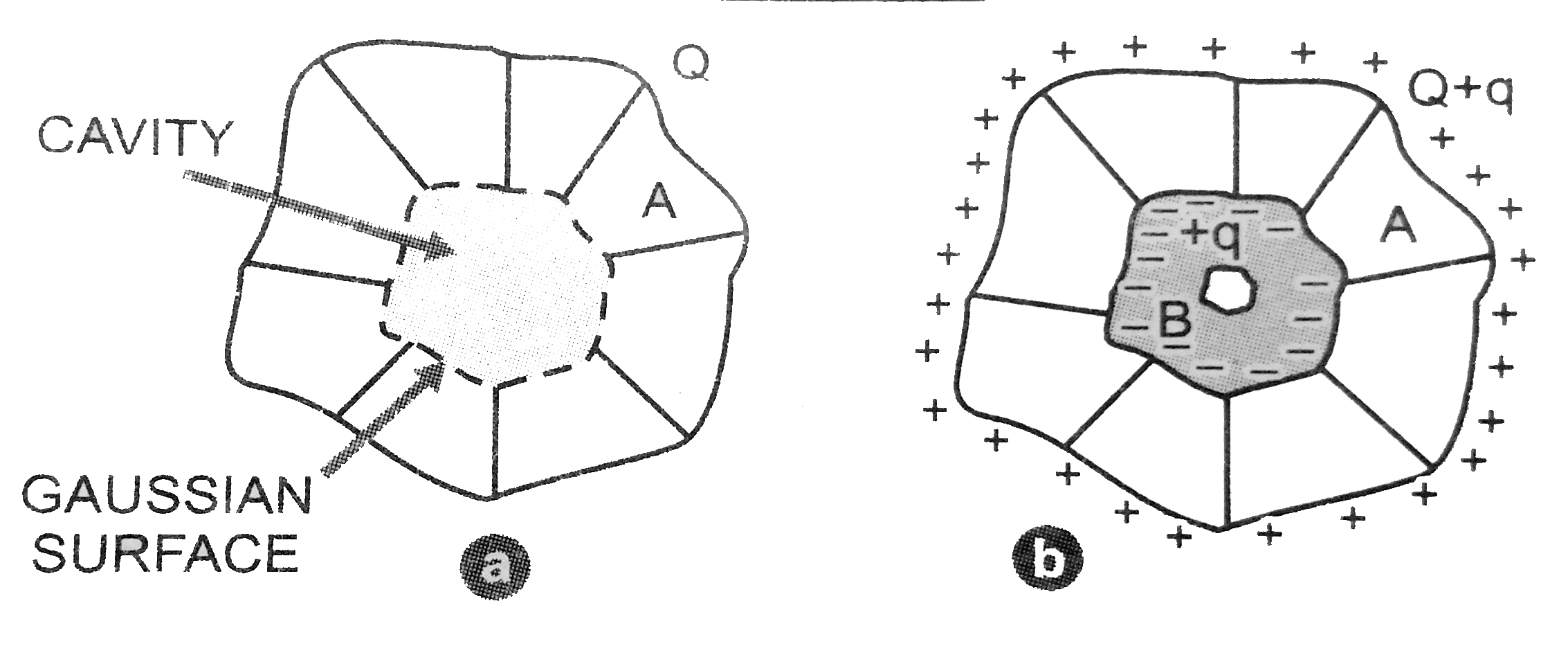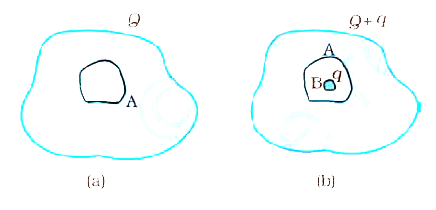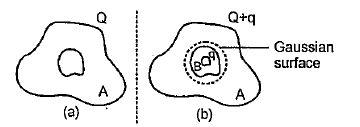(a) A conductor A with a cavity as shown in Fig, is given a charge Q. Show that the entire charge must appear on the outer surface of the conductor.
(b) Another conductor B with charge q is inserted into the cavity keeping B insulated from A. Show that the total charge on the outside surface of A is (Q+q) fig.
(c) A sensitive instrument is to be shielded from the strong electrostatic field in its environment. Suggest a possible way.

a) Let us consider a Gaussian surface that is lying wholly within a conductor and enclosing the cavity. The electric field intensity E inside the charged conductor is zero.
Let q is the charge inside the conductor and ε0 is the permittivity of free space
According to Gauss’s law,
ϕ=¯¯¯E.¯ds=qε0
flux,
Here, E=0
qε0=0
∴ε0≠0
∴q≡0
Therefore, charge inside the conductor is zero. The entire charge Q appears on the outer surface of the conductor.
(b) The outer surface of conductor A has a charge of amount Q. Another conductor B having charge +q is kept inside conductor A and it is insulated from A. Hence, a charge of amount −q will be induced in the inner surface of conductor A and +q is induced on the outer surface of conductor A. Therefore, total charge on the outer surface of conductor A is Q + q.
(c) A sensitive instrument can be shielded from the strong electrostatic field in its environment by enclosing it fully inside a metallic surface. A closed metallic body acts as an electrostatic shield.
Similar Questions
(a) a conductor a with a cavity given a charge Q show that the entire charge must appear on the outer surface of the conductor (b) another condluctor B with charge q is sensitive instrument is to be shielded from the strong electrosatitic fields in its environment suggest a possible way

View Solution(a) a conductor a with a cavity given a charge Q show that the entire charge must appear on the outer surface of the conductor (b) another condluctor B with charge q is sensitive instrument is to be shielded from the strong electrosatitic fields in its environment suggest a possible way

View SolutionA conductor A with a cavity as shown in is given a charge Q. show that the entire charge must appear on the outer surface of the conductor. Another conductor B with charge q is inserted into the cavity keeping B insulated from A. Show that the total charge on the outside surface of A is Q+q (c) A sensitive instrument is to be shielded from the strong electrostatic fields in its environment. Suggest a posible way.
View Solution(a) A conductor A with a cavity as shown in figure (a) is given a charge Q. Show that the entire charge must appear on the outer surface of the conductor.
(b) Another conductor B with charge q is inserted into the cavity keeping B insulated from A. Show that the total charge on the outside surface of A is Q+q figure (b)
( C) A sensitive instruments is to be shielded from the strong electrostatic fields in its environment. Suggest a possible way.

View Solution(a) a conductor a with a cavity given a charge Q show that the entire charge must appear on the outer surface of the conductor (b) another condluctor B with charge q is sensitive instrument is to be shielded from the strong electrosatitic fields in its environment suggest a possible way
View SolutionA conductor A with a cavity as shown in Fig. (a) is given a charge Q. Show that the entire charge must appear on the outer surface of the conductor.

View SolutionAnother conductor B with charge q is inserted into the cavity keeping B insulated from A. Show that the total charge on the outside surface of A is Q+q [Fig (b)]
View SolutionA conductor A with a cavity as shown in Fig. 1.36(a) is given a charge Q. Show that the entire charge must appear on the outer surface of the conductor.:

View Solution
